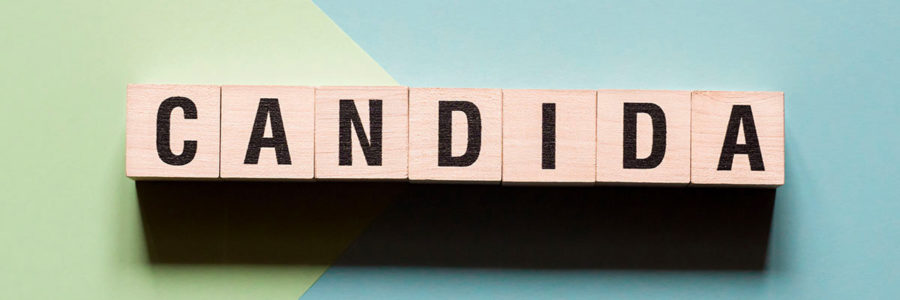Combat Candida: Candida is a fungal infection that affects millions of Americans. With a wide range of associated symptoms, this disease often goes undiagnosed. Today we highlight the tools to overcome this infection once and for all, using all-natural habits that target diet, supplementation, and lifestyle.

This article has been medically reviewed by Dr. Charles Penick, MD
What is Candida?
Candida Albicans (or candida) is a pathogenic yeast that exists in the human body. In of itself, it does not cause problems simply by existing, but when candida overgrows, it causes various symptoms and ailments that interfere with health and wellbeing.
Symptoms of candida overgrowth can include: 1-7
- Brain fog
- Chronic fatigue
- Joint pain
- Depression and anxiety
- Sugar cravings
- Digestive issues
- White coating on the tongue
- Halitosis
- Skin and nail fungal infections
- Recurring vaginal yeast infections
- Recurring urinary tract infections
- Food and environmental allergies
- Hypothyroidism
Candida overgrowth is also known as Candidiasis. This fungal infection can affect both men and women of all ages and immunocompromised and otherwise healthy individuals.8 It appears in various body parts, including toenails, fingernails, nose, mouth, ears, gastrointestinal tract, and vagina.
With such a wide range of symptoms, candida overgrowth often goes misdiagnosed or undiagnosed. Luckily, there are many natural ways to fight it, eliminating candida and promoting overall health and well-being.
What Causes Candida?
Candida is an opportunistic organism, meaning it will take advantage of particular environments to thrive (to grow). The environment that promotes candida yeast overgrowth is primarily rooted in consuming foods, medications, or lifestyle habits that lead to a microbial imbalance in the body.9
Some examples of factors that promote candida include:9-11
- Taking antibiotics
- Taking oral contraceptives
- Using harsh or unnatural anti-bacterial agents in the mouth or on the body (like soaps, mouthwash, or douche gels)
- Consuming high amounts of alcohol
- A diet high in refined sugars and foods
- Diabetes
- High levels of stress
- A weakened immune system
How to Combat Candida
Understanding the causes of candida helps see that addressing it requires a multifaceted approach. Targeting diet, supplementation, and lifestyle habits help target the candida fungal infection itself. It also helps support overall resilience and health so the body can overcome it and keep candida at bay moving forward.
Combat Candida with Diet
The diet component to fight candida is built for two reasons. First of all, to create a solid nutritional base. Nutritional deficiencies often accompany candidiasis, so this diet is rich in nutrient-dense, high-quality foods to ensure that the body is strong enough to fight the overgrowth and the symptoms that may occur during “die-off” (more on this later).12
Second of all, the diet is free from the many foods that promote a bacterial imbalance in the body, encouraging fungal growth. By eliminating these candida-promoting foods and including some fungal-fighting supplements, the body can restore its natural state of balance and health.
Anti-Candida Diet Foods to Consume:
The anti-candida diet is essentially an anti-inflammatory diet that focuses on balanced blood sugar and is very low in sugars. Foods that promote gut healing and contain good bacteria (like fermented foods) can encourage balance in the body, reducing candida overgrowth. Foods with anti-fungal properties are also helpful since candida is a fungal overgrowth.
Foods to consume to combat candida overgrowth include: 13-16
- Apple cider vinegar
- Organic and pasture-raised meats
- Bone broth
- Fermented foods
- Greens (leafy and cruciferous)
- Coconut oil
- Garlic
- Turmeric and ginger
Combat Candida by Avoiding The Following Foods:
The foods to avoid on an anti-candida diet generally promote inflammation, especially foods that encourage an insulin spike. Sugar feeds candida, and so limiting sugar is paramount in reducing candida in the body.17 This includes refined, artificial, and also natural sugars. Depending on how bad the overgrowth is, it is best to avoid high-sugar foods (primarily carbohydrates) while cleansing.
Foods to avoid to reduce candida overgrowth include:17-18
- Refined Sugar (and sugars in general)
- Artificial sweeteners
- Fruit juices or other sugary beverages
- Grains and refined flour
- Conventional dairy/ high lactose (milk sugar) foods
- Refined oils (vegetable oils like canola, soybean, safflower, or margarine)
- Nuts and seeds with high mold (like peanuts)
- Alcohol
- Additives (nitrates or sulfates)
Combat Candida with Supplements
The supplements that help fight off candida do so for two reasons. Some support a robust immune system and balanced microbial function (which provides strength for the body to “fight”). The others are natural anti-fungal agents that act as warriors to support your immune system in eliminating the fungal imbalance.
Supplements that can help combat candida include:19-24
- Probiotics
- Vitamin C
- Magnesium
- Pau d’arco tea
- Olive leaf
- Oregano oil
- Clove oil
- Astragalus root
Lifestyle
Sleep
Sleep quality is imperative when it comes to healing from just about anything. During sleep, the body can spend most of its energy on regenerating and fighting off pathogens. A single night of poor sleep impairs immune function.25
Sleep duration matters, ensuring that you have around 8 hours per night of time to rest– but quality sleep is even more critical.
Sleep quality is generated through habit and by ensuring you have a proper sleep environment. Habit-wise, getting to bed simultaneously, ideally not too long after sundown, helps create a circadian rhythm that promotes deeper sleep. You can also improve your circadian rhythm by getting outside at first sun and avoiding artificial light after sundown.26
A high-quality sleep environment will keep all electronics out of the bedroom; ideally, sleep in a cooler environment, be mindful of a low EMF sleep environment (turn off the wifi at night!), and sleep in a totally dark room.
Stress Management
Stress management is a vital part of any healthy lifestyle plan and is especially important for managing candida overgrowth. Stress weakens the immune system, which promotes an imbalance of bacteria in the body.27 This allows candida to flourish.
Stress comes in physical, chemical, or emotional forms. Being mindful of stress, therefore, requires a holistic approach that deals with mind and body. Exercise, but not excessively, because too much or too little movement can burden the body’s stress response. Avoid toxic chemicals that are found in food, household cleaning products, or body care products. Learn to cope with emotional stress by setting boundaries and cultivating inner peace through mindfulness techniques.
Candida Die-Off Symptoms: The Herxheimer Effect
When the removal of yeast happens very quickly, die-off symptoms can occur that may be rather unpleasant. Known as the Jarisch-Herxheimer reaction (or Herx), this reaction can make you feel worse before you get better.
A common die-off reaction includes flu-like symptoms including:
- Fever
- Chills
- Elevated heart rate
- Muscle aches
- Skin rash
These symptoms can be minimized by easing off on the anti-fungal supplements or cycling through them. Using a proper binder like zeolite or charcoal can help since they shuttle pathogens out of the body. Staying well-hydrated is also key to flushing out fungus.
Summary
Candida is a natural fungus that lives in the body but can wreak havoc if it begins to overgrow. Candida overgrowth is known as Candidiasis and can heal naturally using a multitherapeutic holistic approach that targets diet, supplementation, and lifestyle. Combat candida by implementing a low-sugar, anti-inflammatory diet, using supplements to boost the immune system, and natural antifungals, paired with high-quality sleep and stress management, will promote a natural restoration of candida levels in the body.
Candida Supplements that Work
Your body needs a certain amount of fungi and bacteria to thrive. When one of these organisms starts proliferating out of control, the symptoms begin… That’s why it’s essential to address fungal overgrowth naturally and holistically, without killing everything else while you’re at.
The Candida Series from Des Bio is a gentle yet powerful formulation designed to relieve symptoms like nausea, drowsiness, lethargy, confusion, vertigo, and other side effects of candida overgrowth. In the short term, homeopathic remedies are perfect for alleviating discomfort. In the long-term, they can help to rebalance your body and boost immunity to prevent further infection…
All without the harsh side effects of other, more intense medications.
Medical Disclaimer: This article is based on the opinions of The Cell Health team. The information on this website is not intended to replace a one-on-one relationship with a qualified healthcare professional and is not intended as medical advice. It is intended to share knowledge and information from the research and experience of the Cell Health team. This article has been medically reviewed by Dr. Charles Penick, MD, for the accuracy of the information provided. Still, we encourage you to make your own healthcare decisions based on your research and in partnership with a qualified healthcare professional.
References
- Farah, C S et al. “Oral fungal infections: an update for the general practitioner.” Australian dental journal vol. 55 Suppl 1 (2010): 48-54. doi:10.1111/j.1834-7819.2010.01198.x
- Cater, R E 2nd. “Chronic intestinal candidiasis as a possible etiological factor in the chronic fatigue syndrome.” Medical hypotheses vol. 44,6 (1995): 507-15. doi:10.1016/0306-9877(95)90515-4
- Achkar, Jacqueline M, and Bettina C Fries. “Candida infections of the genitourinary tract.” Clinical microbiology reviews vol. 23,2 (2010): 253-73. doi:10.1128/CMR.00076-09
- Kumamoto, Carol A. “Inflammation and gastrointestinal Candida colonization.” Current opinion in microbiology vol. 14,4 (2011): 386-91. doi:10.1016/j.mib.2011.07.015
- Al Hasan, Muhannad et al. “Dermatology for the practicing allergist: Tinea pedis and its complications.” Clinical and molecular allergy: CMA vol. 2,1 5. 29 Mar. 2004, doi:10.1186/1476-7961-2-5
- Gamaletsou, Maria N et al. “Candida Arthritis: Analysis of 112 Pediatric and Adult Cases.” Open forum infectious diseases vol. 3,1 ofv207. 23 Dec. 2015, doi:10.1093/ofid/ofv207
- Denise Devore-Carter, Sujata Kar, Vincent Vellucci, Vasker Bhattacherjee, Paul Domanski, Margaret K Hostetter, Superantigen-Like Effects of a Candida albicans Polypeptide, The Journal of Infectious Diseases, Volume 197, Issue 7, 1 April 2008, Pages 981–989, https://doi.org/10.1086/529203
- Martins, Natália et al. “Candidiasis: predisposing factors, prevention, diagnosis and alternative treatment.” Mycopathologia vol. 177,5-6 (2014): 223-40. doi:10.1007/s11046-014-9749-1
- Mason, Katie L et al. “Candida albicans and bacterial microbiota interactions in the cecum during recolonization following broad-spectrum antibiotic therapy.” Infection and immunity vol. 80,10 (2012): 3371-80. doi:10.1128/IAI.00449-12
- Seelig, Mildred S. “The Role of Antibiotics in the Pathogenesis of Candida Infections.” The American Journal of Medicine, vol. 40, no. 6, 1966, pp. 887–917., doi:10.1016/0002-9343(66)90204-x.
- Meyer, Harald et al. “Stress as a cause of chronic recurrent vulvovaginal candidosis and the effectiveness of the conventional antimycotic therapy.” Mycoses vol. 49,3 (2006): 202-9. doi:10.1111/j.1439-0507.2006.01235.x
- Galland, Leo. “Nutrition and Candidiasis.” Ortho Mollecular, 1985, www.orthomolecular.org/library/jom/1985/pdf/1985-v14n01-p050.pdf.
- Shino, Beena et al. “Comparison of Antimicrobial Activity of Chlorhexidine, Coconut Oil, Probiotics, and Ketoconazole on Candida albicans Isolated in Children with Early Childhood Caries: An In Vitro Study.” Scientifica vol. 2016 (2016): 7061587. doi:10.1155/2016/7061587
- Khodavandi, Alireza et al. “Comparison between efficacy of allicin and fluconazole against Candida albicans in vitro and in a systemic candidiasis mouse model.” FEMS microbiology letters vol. 315,2 (2011): 87-93. doi:10.1111/j.1574-6968.2010.02170.x
- Shams-Ghahfarokhi, Masoomeh et al. “In vitro antifungal activities of Allium cepa, Allium sativum and ketoconazole against some pathogenic yeasts and dermatophytes.” Fitoterapia vol. 77,4 (2006): 321-3. doi:10.1016/j.fitote.2006.03.014
- Carol Kumamoto et al. Manipulation of Host Diet To Reduce Gastrointestinal Colonization by the Opportunistic Pathogen Candida albicans. mSphere, November 2015 DOI: 10.1128/mSphere.00020-15
- Weig, M et al. “Limited effect of refined carbohydrate dietary supplementation on the colonization of the gastrointestinal tract of healthy subjects by Candida albicans.” The American journal of clinical nutrition vol. 69,6 (1999): 1170-3. doi:10.1093/ajcn/69.6.1170
- Martins, Natália et al. “Candidiasis: predisposing factors, prevention, diagnosis and alternative treatment.” Mycopathologia vol. 177,5-6 (2014): 223-40. doi:10.1007/s11046-014-9749-1
- Spampinato, Claudia, and Darío Leonardi. “Candida infections, causes, targets, and resistance mechanisms: traditional and alternative antifungal agents.” BioMed research international vol. 2013 (2013): 204237. doi:10.1155/2013/204237
- Mailänder-Sánchez D, Wagener J, Schaller M. Potential role of probiotic bacteria in the treatment and prevention of localised candidosis. Mycoses. 2012 Jan;55(1):17-26. doi: 10.1111/j.1439-0507.2010.01967.x. Epub 2011 Jun 14. PMID: 21672043.
- Kumar, Awanish et al. “Curcumin targets cell wall integrity via calcineurin-mediated signaling in Candida albicans.” Antimicrobial agents and chemotherapy vol. 58,1 (2014): 167-75. doi:10.1128/AAC.01385-13
- Mikaeili, Ali, et al. “Anti-Candidal Activity of Astragalus Verus in the in Vitro and in Vivo Guinea Pig Models of Cutaneous and Systemic Candidiasis.” Revista Brasileira De Farmacognosia, vol. 22, no. 5, 2012, pp. 1035–1043., doi:10.1590/s0102-695×2012005000035.
- Pozzatti, Patrícia et al. “In vitro activity of essential oils extracted from plants used as spices against fluconazole-resistant and fluconazole-susceptible Candida spp.” Canadian journal of microbiology vol. 54,11 (2008): 950-6. doi:10.1139/w08-097
- Van Hauwenhuyse, Frédérique et al. “Ascorbic acid inhibition of Candida albicans Hsp90-mediated morphogenesis occurs via the transcriptional regulator Upc2.” Eukaryotic cell vol. 13,10 (2014): 1278-89. doi:10.1128/EC.00096-14
- Asif, Nayyab et al. “Human immune system during sleep.” American journal of clinical and experimental immunology vol. 6,6 92-96. 20 Dec. 2017
- Walker, Matthew P. Why We Sleep: the New Science of Sleep and Dreams. Penguin Books, 2018.
- Segerstrom, Suzanne C, and Gregory E Miller. “Psychological stress and the human immune system: a meta-analytic study of 30 years of inquiry.” Psychological bulletin vol. 130,4 (2004): 601-30. doi:10.1037/0033-2909.130.4.601


